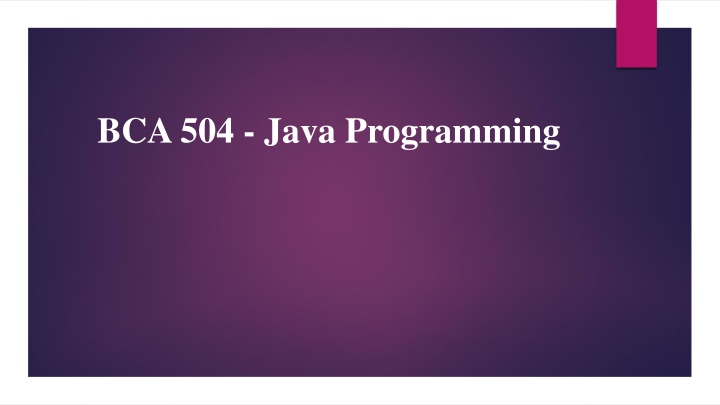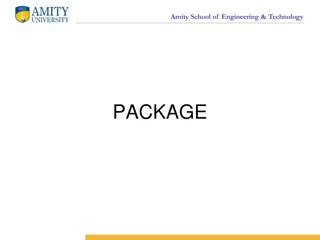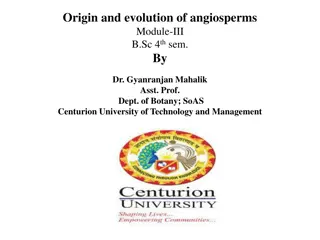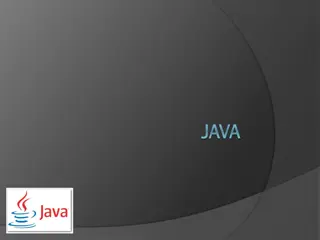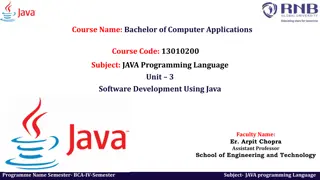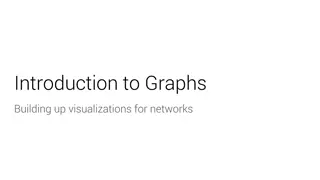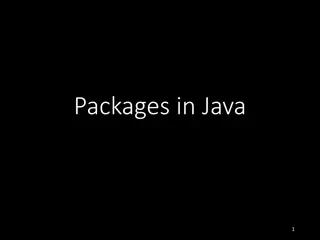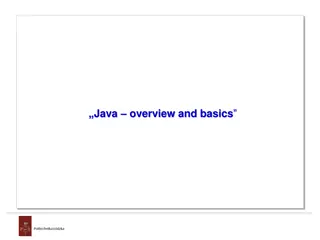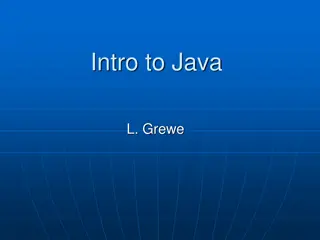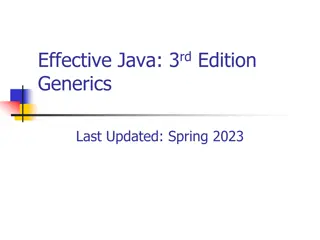The Origin of Java: Conception and Evolution
Java, initially known as Oak, originated in 1991 through the efforts of James Gosling and others at Sun Microsystems. Transitioning from C and C++, Java emerged as a versatile, platform-independent language pivotal for embedded software in diverse electronic devices. Java's affinity with the internet empowered its significance in programming, introducing innovations like Java applets that revolutionized web content delivery. The interplay between Java, C, C++, and C# underscores the language's evolution within the modern programming landscape.
Download Presentation

Please find below an Image/Link to download the presentation.
The content on the website is provided AS IS for your information and personal use only. It may not be sold, licensed, or shared on other websites without obtaining consent from the author.If you encounter any issues during the download, it is possible that the publisher has removed the file from their server.
You are allowed to download the files provided on this website for personal or commercial use, subject to the condition that they are used lawfully. All files are the property of their respective owners.
The content on the website is provided AS IS for your information and personal use only. It may not be sold, licensed, or shared on other websites without obtaining consent from the author.
E N D
Presentation Transcript
The Origin of Java Java was conceived by James Gosling, Patrick Naughton, Chris Warth, Ed Frank, and Mike Sheridan at Sun Microsystems in 1991. This language was initially called Oak but was renamed Java in 1995. The original movement for Java was not the internet; instead, the primary motivation was the need for a platform-independent language that could be used to create software to be embedded in various consumer electronic devices, such as toasters, microwave ovens, and remote controls. The World Wide Web would play a crucial role in the future of Java.
How Java Relates to C and C++: Java is directly related to both C and C++. Java inherits its syntax from C. Its object model is adapted from C++. Java s relationship with C and C++ is important for several reasons. First, many programmers are familiar with the C/C++ syntax. This makes it easy for a C/C++ programmer to learn Java The modern age of programming began with C. It moved to C++, and now to Java. Java is an Interpreted language and Platform Independent
How Java Relates to C# A few years after the creation of Java, Microsoft developed the C# language. This is important because C# is closely related to Java. In fact, many of C# s features directly parallel Java. Both Java and C# share the same general C++-style syntax, support distributed programming, and utilize the same object model.
Javas contribution to the internet The Internet helped throw Java to the forefront of programming, and Java, in turn, had a profound effect on the Internet. In addition to simplifying web programming in general, Java innovated a new type of networked program called the applet that changed the way the online world thought about content. Java also addressed some of the important issues associated with the Internet: portability and security.
Java Applets An applet is a special kind of Java program that is designed to be transmitted over the Internet and automatically executed by a Java-compatible web browser. An applet is downloaded on demand, without further interaction with the user. If the user clicks a link that contains an applet, the applet will be automatically downloaded and run in the browser. They are typically used to display data provided by the server, handle user input, or provide simple functions, such as a loan calculator, that execute locally, rather than on the server.
Security Every time that you download a normal program, you are taking a risk because the code you are downloading might contain a virus, Trojan horse, or other harmful code. At the core of the problem is the fact that malicious code can cause its damage because it has gained unauthorized access to system resources. In order for Java to enable applets to be safely downloaded and executed on the client computer, it was necessary to prevent an applet from launching such an attack.
Portability Portability is a major aspect of the Internet because there are many different types of computers and operating systems connected to it. If a Java program were to be run on virtually any computer connected to the Internet, there needed to be some way to enable that program to execute on different systems.
Java Bytecode The key that allows Java to solve both the security and the portability problems is that the output of a Java compiler is not executable code. Rather, it is byte code. Bytecode is a highly optimized set of instructions designed to be executed by the Java run-time system, which is called the Java Virtual Machine (JVM). Java program is executed by the JVM helps to solve the major problems associated with web-based programs. Translating a Java program into bytecode makes it much easier to run a program in a wide variety of environments because only the JVM needs to be implemented for each platform. Once the run-time package exists for a given system, any Java program can run on it.
The Java Buzzwords Simple: Java is a small and simple language. Java does not use pointers, pre- processor header files, goto statement and many others. It also eliminates operator overloading and multiple inheritance. Secure: Java provides a secure means of creating internet applications. Java systems not only verify all memory access but also ensure that no viruses are communicated with an applet. Portable: Java ensures portability in two ways. First, Java compiler generates bytecode instructions that can be implemented on any machine. Secondly, the sizes of the primitive data types are machine- independent. Robust: It has strict compile time and run time checking for data types. It is designed as a garbage-collected language relieving the programmers virtually all memory management problems.
Multithreaded: Multithreaded means handling multiple task-simultaneously. Java supports multithreaded programs. Architecture Neutral: Java is not tied to a specific machine or operating system architecture. Interpreted: Java supports cross-platform code through the use of Java bytecode. Byte codes are not machine instructions and therefore, in the second stage, Java interpreter generates machine code that can be directly executed by the machine that is running the Java program. High Performance: Java performance is impressive for an interpreted language, mainly due to the use of intermediate bytecode.
Distributed: Java is designed as a distributed language for creating applications on networks. It has the ability to share both data and programs. Java applications can open and access remote objects on Internet as easily as they can do in a local system. Dynamic: Java is a dynamic language. Java is capable of dynamically linking in new class libraries, methods, and objects. Java can also determine the type of class through a query, making it possible to either dynamically link or abort the program, depending on the response
